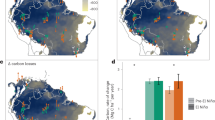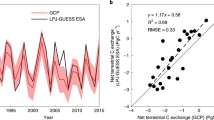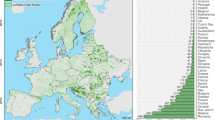Abstract
Tropical forests have undergone extensive deforestation and degradation during the past few decades, but the area and the carbon loss due to degradation could be larger than the losses from deforestation. Degraded forests also induce biophysical feedback on climate, as they sustain less cooling from evapotranspiration. Here we estimate the biophysical and biogeochemical temperature changes caused by tropical moist forest degradation using high-resolution remote sensing data from 2010. Degraded forests, including burned, isolated, edge and other degraded forests, account for 24.1% of the total tropical moist forest area. The land surface temperature of degraded tropical moist forests is higher than that of nearby intact forests, leading to a warming effect of 0.022 ± 0.014 °C over the tropics. The cumulative carbon deficit of degraded forests reaches 6.1 ± 2.0 PgC, equivalent to a biogeochemical warming effect of 0.026 ± 0.013 °C. Forest degradation caused by anthropogenic disturbances from 1990 to 2010 induces a daytime warming effect of 0.018 ± 0.008 °C and a carbon deficit of 2.3 ± 0.8 PgC. These values are of the same order of magnitude as those due to deforestation. Our results emphasize the importance of accounting for the combined biophysical and biogeochemical effects in mitigation pledges related to reducing forest degradation and the restoration of tropical forest.
This is a preview of subscription content, access via your institution
Access options
Access Nature and 54 other Nature Portfolio journals
Get Nature+, our best-value online-access subscription
$29.99 / 30 days
cancel any time
Subscribe to this journal
Receive 12 print issues and online access
$259.00 per year
only $21.58 per issue
Buy this article
- Purchase on Springer Link
- Instant access to full article PDF
Prices may be subject to local taxes which are calculated during checkout




Similar content being viewed by others
Data availability
The 30 m TMF15 dataset can be downloaded from https://forobs.jrc.ec.europa.eu/TMF/download/. The 25 m biomass data from GlobBiomass can be downloaded from https://doi.org/10.5281/zenodo.4725667 (Africa), https://doi.org/10.5281/zenodo.7544238 (South America, north), https://doi.org/10.5281/zenodo.7544946 (South America, south) and https://doi.org/10.5281/zenodo.7545054 (South Asia). A search in Zenodo for ‘Globbiomass’ will return data for other regions. The 100 m biomass data from CCIBiomass46 can be downloaded from https://doi.org/10.5285/5f331c418e9f4935b8eb1b836f8a91b8. The 250 m FireCCI burned area data26 can be downloaded from https://geogra.uah.es/fire_cci/firecci51.php. The 30 m tree cover map in 201052 can be downloaded from https://glad.umd.edu/dataset/global-2010-tree-cover-30-m. The 30 m Landsat LST dataset28 can be downloaded from https://earthexplorer.usgs.gov/. The 30 m ASTER DEM V3 dataset can be downloaded from https://search.earthdata.nasa.gov/search. The 1 km MODIS LST dataset29 can be downloaded from https://ladsweb.modaps.eosdis.nasa.gov/. CMIP5 data can be downloaded from https://esgf-node.llnl.gov/search/cmip5/. The source data for Figs.1–4 and Extended Data Figs. 2–6 are available via Zenodo at https://doi.org/10.5281/zenodo.7544889.
Code availability
The Python script used to analyse the data is available at https://github.com/zhu3210/Tropical-forest-degradation.
References
Pan, Y. et al. A large and persistent carbon sink in the world’s forests. Science 333, 988–993 (2011).
Friedlingstein, P. et al. Global carbon budget 2022. Earth Syst. Sci. Data 14, 4811–4900 (2022).
Peng, S.-S. et al. Afforestation in China cools local land surface temperature. Proc. Natl Acad. Sci. USA 111, 2915–2919 (2014).
Li, Y. et al. Local cooling and warming effects of forests based on satellite observations. Nat. Commun. 6, 6603 (2015).
Houghton, R. A. & Nassikas, A. A. Global and regional fluxes of carbon from land use and land cover change 1850-2015. Glob. Biogeochem. Cycles 31, 456–472 (2017).
Alkama, R. & Cescatti, A. Biophysical climate impacts of recent changes in global forest cover. Science 351, 600–604 (2016).
Longo, M. et al. Aboveground biomass variability across intact and degraded forests in the Brazilian Amazon. Glob. Biogeochem. Cycles 30, 1639–1660 (2016).
Qie, L. et al. Long-term carbon sink in Borneo’s forests halted by drought and vulnerable to edge effects. Nat. Commun. 8, 1966 (2017).
Smith, I. A., Hutyra, L. R., Reinmann, A. B., Marrs, J. K. & Thompson, J. R. Piecing together the fragments: elucidating edge effects on forest carbon dynamics. Front. Ecol. Environ. 16, 213–221 (2018).
Franklin, C. M. A., Harper, K. A. & Clarke, M. J. Trends in studies of edge influence on vegetation at human-created and natural forest edges across time and space. Can. J. For. Res. 51, 274–282 (2020).
Hansen, M. C. et al. The fate of tropical forest fragments. Sci. Adv. 6, eaax8574 (2020).
Matricardi, E. A. T. et al. Long-term forest degradation surpasses deforestation in the Brazilian Amazon. Science 369, 1378–1382 (2020).
Baccini, A. et al. Tropical forests are a net carbon source based on aboveground measurements of gain and loss. Science 358, 230–234 (2017).
Qin, Y. et al. Carbon loss from forest degradation exceeds that from deforestation in the Brazilian Amazon. Nat. Clim. Change 11, 442–448 (2021).
Vancutsem, C. et al. Long-term (1990–2019) monitoring of forest cover changes in the humid tropics. Sci. Adv. 7, eabe1603 (2021).
Schoene, D., Killmann, W., Lüpke, H. V. & LoycheWilkie, M. Forests and Climate Change Working Paper 5: Definitional Issues Related to Reducing Emissions from Deforestation in Developing Countries (FAO, 2007).
Goetz, S. J. et al. Measurement and monitoring needs, capabilities and potential for addressing reduced emissions from deforestation and forest degradation under REDD+. Environ. Res. Lett. 10, 123001 (2015).
Pearson, T. R. H., Brown, S., Murray, L. & Sidman, G. Greenhouse gas emissions from tropical forest degradation: an underestimated source. Carbon Balance Manag. 12, 3 (2017).
Cadenasso, M. L., Traynor, M. M. & Pickett, S. T. Functional location of forest edges: gradients of multiple physical factors. Can. J. For. Res. 27, 774–782 (1997).
Schmidt, M., Jochheim, H., Kersebaum, K.-C., Lischeid, G. & Nendel, C. Gradients of microclimate, carbon and nitrogen in transition zones of fragmented landscapes – a review. Agric. For. Meteorol. 232, 659–671 (2017).
Bonan, G. B. Forests and climate change: forcings, feedbacks, and the climate benefits of forests. Science 320, 1444–1449 (2008).
Silva Junior, C. H. L. et al. Amazonian forest degradation must be incorporated into the COP26 agenda. Nat. Geosci. 14, 634–635 (2021).
Bala, G. et al. Combined climate and carbon-cycle effects of large-scale deforestation. Proc. Natl Acad. Sci. USA 104, 6550–6555 (2007).
Windisch, M. G., Davin, E. L. & Seneviratne, S. I. Prioritizing forestation based on biogeochemical and local biogeophysical impacts. Nat. Clim. Change 11, 867–871 (2021).
Santoro, M. et al. The global forest above-ground biomass pool for 2010 estimated from high-resolution satellite observations. Earth Syst. Sci. Data 13, 3927–3950 (2021).
Chuvieco, E. et al. Generation and analysis of a new global burned area product based on MODIS 250 m reflectance bands and thermal anomalies. Earth Syst. Sci. Data 10, 2015–2031 (2018).
Zhao, Z. et al. Fire enhances forest degradation within forest edge zones in Africa. Nat. Geosci. https://doi.org/10.1038/s41561-021-00763-8 (2021).
Cook, M., Schott, J. R., Mandel, J. & Raqueno, N. Development of an operational calibration methodology for the Landsat thermal data archive and initial testing of the atmospheric compensation component of a land surface temperature (LST) product from the archive. Remote Sens. https://doi.org/10.3390/rs61111244 (2014).
Wan, Z. New refinements and validation of the collection-6 MODIS land-surface temperature/emissivity product. Remote Sens. Environ. 140, 36–45 (2014).
Broadbent, E. N. et al. Forest fragmentation and edge effects from deforestation and selective logging in the Brazilian Amazon. Biol. Conserv. 141, 1745–1757 (2008).
Chaplin-Kramer, R. et al. Degradation in carbon stocks near tropical forest edges. Nat. Commun. 6, 10158 (2015).
Silva Junior, C. et al. Persistent collapse of biomass in Amazonian forest edges following deforestation leads to unaccounted carbon losses. Sci. Adv. 6, eaaz8360 (2020).
Laurance, W. F. et al. Biomass collapse in Amazonian forest fragments. Science 278, 1117–1118 (1997).
Mu, Q., Zhao, M. & Running, S. W. Improvements to a MODIS global terrestrial evapotranspiration algorithm. Remote Sens. Environ. 115, 1781–1800 (2011).
Zheng, C., Jia, L. & Hu, G. Global land surface evapotranspiration monitoring by ETMonitor model driven by multi-source satellite Earth observations. J. Hydrol. 613, 128444 (2022).
Brinck, K. et al. High resolution analysis of tropical forest fragmentation and its impact on the global carbon cycle. Nat. Commun. 8, 14855 (2017).
Laurance, W. F. et al. The fate of Amazonian forest fragments: a 32-year investigation. Biol. Conserv. 144, 56–67 (2011).
de Paula, M. D., Costa, C. P. A. & Tabarelli, M. Carbon storage in a fragmented landscape of Atlantic forest: the role played by edge-affected habitats and emergent trees. Trop. Conserv. Sci. 4, 349–358 (2011).
van der Werf, G. R. et al. Global fire emissions estimates during 1997–2016. Earth Syst. Sci. Data 9, 697–720 (2017).
Gillett, N. P., Arora, V. K., Matthews, D. & Allen, M. R. Constraining the ratio of global warming to cumulative CO2 emissions using CMIP5 simulations. J. Clim. 26, 6844–6858 (2013).
Bowman, D. M. J. S. et al. Vegetation fires in the Anthropocene. Nat. Rev. Earth Environ. 1, 500–515 (2020).
Kozlowski, T. T. Responses of woody plants to flooding and salinity. Tree Physiol. 17, 490–490 (1997).
Garnett, S. T. et al. A spatial overview of the global importance of Indigenous lands for conservation. Nat. Sustain. 1, 369–374 (2018).
Sze, J. S., Carrasco, L. R., Childs, D. & Edwards, D. P. Reduced deforestation and degradation in Indigenous lands pan-tropically. Nat. Sustain. 5, 123–130 (2022).
Masson-Delmotte, V. et al. IPCC: Summary for Policymakers. In Climate Change 2021: The Physical Science Basis (eds) (Cambridge Univ. Press, 2021).
Santoro, M. & Cartus, O. ESA Biomass Climate Change Initiative (Biomass_cci): Global Datasets of Forest Above-Ground Biomass for the Years 2010, 2017 and 2018, v3 (NERC EDS Centre for Environmental Data Analysis, 2021); https://doi.org/10.5285/5f331c418e9f4935b8eb1b836f8a91b8
Gerland, P. et al. World population stabilization unlikely this century. Science 346, 234–237 (2014).
Alkama, R. et al. Vegetation-based climate mitigation in a warmer and greener world. Nat. Commun. 13, 606 (2022).
Duveiller, G., Hooker, J. & Cescatti, A. The mark of vegetation change on Earth’s surface energy balance. Nat. Commun. 9, 679 (2018).
Matthews, H. D., Gillett, N. P., Stott, P. A. & Zickfeld, K. The proportionality of global warming to cumulative carbon emissions. Nature 459, 829–832 (2009).
Li, W. et al. Land-use and land-cover change carbon emissions between 1901 and 2012 constrained by biomass observations. Biogeosciences 14, 5053–5067 (2017).
Hansen, M. C. et al. High-resolution global maps of 21st-century forest cover change. Science 342, 850–853 (2013).
Acknowledgements
This study was supported by the National Key R&D Program of China (grant number 2019YFA0606604, to W.L.), the National Natural Science Foundation of China (grant number 42175169, to W.L.) and the Tsinghua University Initiative Scientific Research Program (grant number 2022308004, to W.L.). P.C. acknowledges support from the ANR CLAND Convergence Institute 16-CONV-0003 (to P.C.). The authors thank M. G. Windisch for providing the TCRE data and S. T. Garnett for providing the Indigenous lands map.
Author information
Authors and Affiliations
Contributions
W.L. designed the research. L.Z. performed analysis. M.S. and O.C. processed the biomass map data. L.Z. and W.L. drafted the paper. All authors contributed to the interpretation of the results and to the text.
Corresponding author
Ethics declarations
Competing interests
The authors declare no competing interests.
Peer review
Peer review information
Nature Geoscience thanks Yue Li and the other, anonymous, reviewer(s) for their contribution to the peer review of this work. Primary Handling Editor: Xujia Jiang, in collaboration with the Nature Geoscience team.
Additional information
Publisher’s note Springer Nature remains neutral with regard to jurisdictional claims in published maps and institutional affiliations.
Extended data
Extended Data Fig. 1 Flow chart of input data (white), derived data (blue), and results (red) described in the Methods.
TMF, tropical moist forest; CCI, climate change initiative; DEM, digital elevation model; LST, land surface temperature; TCRE, transient climate response to cumulative carbon emissions.
Extended Data Fig. 2 The distribution of edge distance.
a, The spatial distribution of edge distance for TMFs. b, The kernel density distribution of edge distance for different regions. The dashed lines indicate the area-weighted means.
Extended Data Fig. 3 Spatial distribution of degraded forests (a−d) and interior forests (e).
The numbers show the total area.
Extended Data Fig. 4 Kernel density distribution of TC fraction change (ΔTC, a) and the correlation between ΔTC and ΔLST over the tropics (b).
ΔTC is calculated as the TC fraction of interior forests minus the TC fraction of the paired land cover type. ΔLST is calculated as the LST of each land cover type minus the LST of paired interior forests using the Landsat daytime LST data. Coloured dashed lines and numbers in a show the area-weighted mean values.
Extended Data Fig. 5 Spatial distribution of recently created degraded forest (a, c) and other isolated, edge (b, d) forest.
The numbers are the corresponding area for each forest degradation.
Extended Data Fig. 6 Comparison of carbon deficit from isolated and edge forests formed after 2000 with the deforestation carbon emissions from the national reports (UNFCCC) and satellite observations (GFC) during 2000–2010 for nine countries.
Error bars denote the standard deviation. N = 4609 (2458), 13862 (9985), 4820 (3004), 2402 (1444), 838 (427), 2930 (1240), 1175 (606), 391 (404) and 211 (234) for carbon deficit from forest degradation (deforestation) in the nine countries (from left to right in the figure), respectively. UNFCCC, United Nations Framework Convention on Climate Change; GFC, Global Forest Change; TMF, Tropical Moist Forest; DRC, Democratic Republic of the Congo; PNG, Papua New Guinea.
Supplementary information
Supplementary Information
Supplementary Methods, Supplementary Texts 1–8, Supplementary Figs. 1–18 and Supplementary Table 1.
Rights and permissions
Springer Nature or its licensor (e.g. a society or other partner) holds exclusive rights to this article under a publishing agreement with the author(s) or other rightsholder(s); author self-archiving of the accepted manuscript version of this article is solely governed by the terms of such publishing agreement and applicable law.
About this article
Cite this article
Zhu, L., Li, W., Ciais, P. et al. Comparable biophysical and biogeochemical feedbacks on warming from tropical moist forest degradation. Nat. Geosci. 16, 244–249 (2023). https://doi.org/10.1038/s41561-023-01137-y
Received:
Accepted:
Published:
Issue Date:
DOI: https://doi.org/10.1038/s41561-023-01137-y
This article is cited by
-
Long-Term Effects of Ecological Restoration Projects on Ecosystem Services and Their Spatial Interactions: A Case Study of Hainan Tropical Forest Park in China
Environmental Management (2024)
-
Gains and losses in forest cover have asymmetric effects on land surface temperature
Nature Climate Change (2023)
-
Asymmetric influence of forest cover gain and loss on land surface temperature
Nature Climate Change (2023)



